
|
|
SUBSIM: The Web's #1 resource for all submarine & naval simulations since 1997
 |
SUBSIM: The Web's #1 resource for all submarine & naval simulations since 1997 |
|
|||||||||
 |
|
|
Thread Tools | Display Modes |
 06-15-18, 02:29 PM
06-15-18, 02:29 PM
|
#1 |
|
Watch Officer
 Join Date: Apr 2005
Location: massachusetts
Posts: 334
Downloads: 237
Uploads: 0
|
with the constant bearing method explained and posted, the arcade nature of this game is over, but there were two others methods in the TFCM that were taught to u.s. submarines crews, the check bearing and continuous bearing methods. these methods, like the constant bearing method, have very little to go on, and so its alittle like reverse engineering, accept in most cases, there had to be some kind of product in hand to reverse engineer. there is nothing online or in the manual to explain these methods, accept a procedure when firing these methods, the angular set up of the track isnt mentioned, there is nothing, but I think I'm beginning to make headway on these methods and maybe, just maybe.
all three methods could not have been for a ninety track, that would be redundant, these other two had to be made for different angular tracks, but then again, one of these might be for a right angle, like the constant bearing method is, but it may use a different set up of the right angle. in the constant bearing method, the hypotenuse of the right triangle is the bearing and the range to the target, but I think in one of these other methods, the hypotenuse of the right triangle is used for the targets course, it looks like a 45-45 right triangle, and therefore an Isosceles right triangle, the bearing to target will be 90 degrees, and the target and submarine or torpedoes are heading to a collision point, which will be one of the acute angles in the triangle, I'm almost going to commit and say that this angular setup is either the check bearing or the continuous bearing method. one of these methods maybe in the picture below from the TFCM. 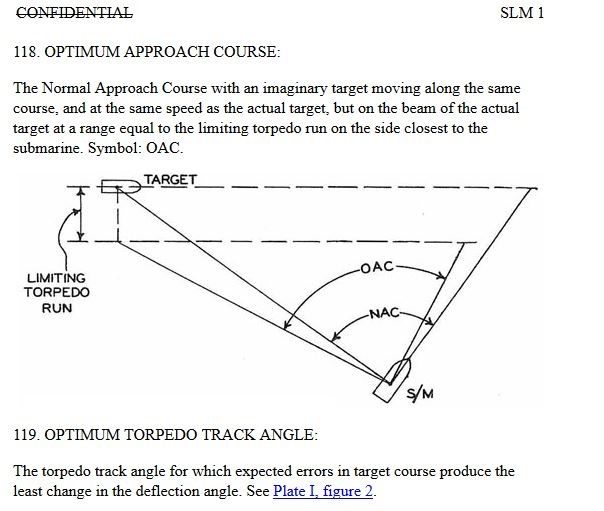 so if there are two ways to use a right triangle in a firing method, it means the right triangle has been completely used up, so one of these other methods was made for a triangle other than a right triangle. I figure it must be either an Isosceles, where target course distance to torpedo impact is the same as the range to target, since Isosceles triangles have two congruent sides. if it's not Isosceles, then it maybe a equilateral or equiangular triangle, and if it's equiangular, that makes it equilateral. Isosceles setup 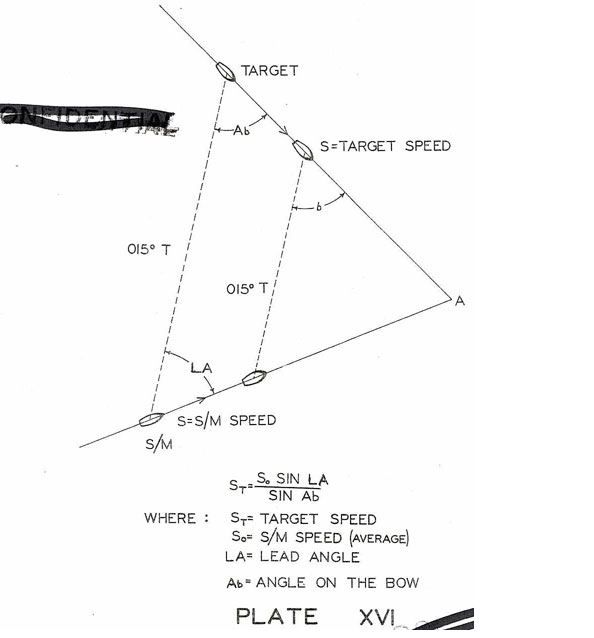 so it looks like just setting up test missions, with these angular setups, and then apply the procedures spoken of in the tfcm, and figure out just what they mean by check bearing and continuous bearing. anyone that wants to help can, you won't be doing it for me, you will be doing it for the community, and for realism.
__________________
Her gun crew had guts, however, for from her canting bow came a half dozen well-aimed rounds. How they pointed and trained their gun on that tilting platform will long remain a wonder, and their dedication in keeping up the fire until they went under would be a matter of pride to any nation. O'Kane, Richard. Clear the Bridge!: The War Patrols of the U.S.S. Tang |

|

|
 06-16-18, 11:00 AM
06-16-18, 11:00 AM
|
#2 |
|
Watch Officer
 Join Date: Apr 2005
Location: massachusetts
Posts: 334
Downloads: 237
Uploads: 0
|
I worked on this problem last nite, using the angular setup of the normal approach course.
it's pretty safe to say at this point, that this is the setup for the continuous bearing method, it's a 45-45 right triangle. the pic below is the test mission from silent hunter editor, target speed is 5 knots, the bearing to target is 270 degrees, the aob of the target ship is starboard 45 degrees, from here the aob increases by one for every degree of target advance, so it looks like the aob can be known at all times, by looking at the bearing of the target, and adding the number of bearings the target advanced from 270, and add that to 45. example: target's bearing is now 300 degrees, that's a thirty degree target advance from 270 degrees, add 30 to 45 and the aob at bearing 300 will be 75 degrees. that in itself is continuous, the aob keeps increasing by one degree continuously. this ship gets the torpedoes right in the stern. for the shooting side of it, I still have some consolidation to make, but I could fire torpedoes and hit the target at 5 knots beginning at 349 degrees, and use every bearing continuously as a firing bearing from 349 to at least zero degrees, that's 11 firing bearings, I think there's a few more, I just went to zero for now. 349 degrees would be the generated bearing for this angular setup. the range decreases until the target ship gets to the midpoint of the hypotenuse, after going thru the midpoint, the target begins to increase in range. now its just a matter of consistency of all the speeds the opfor has, 1 knot to 36 knots, I think it goes that high.  extra line drawn to show the 90 degree angle 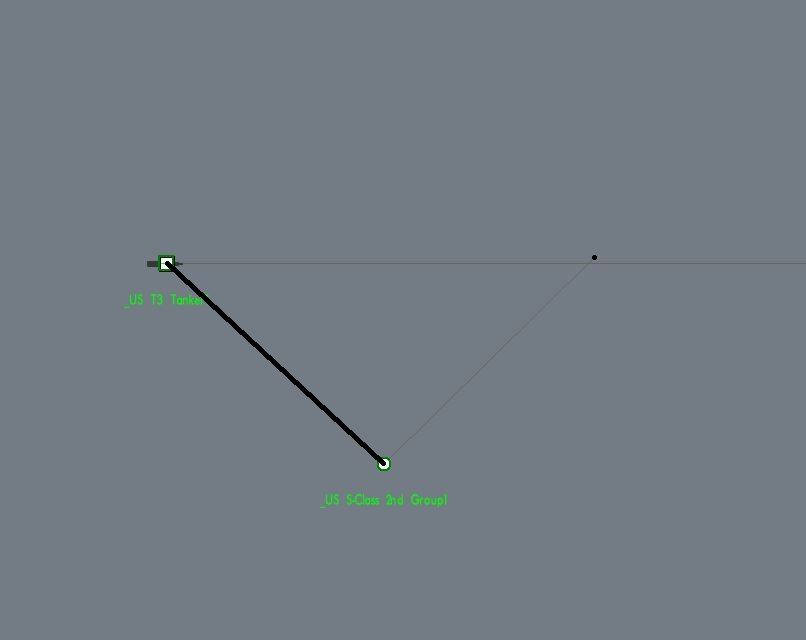
__________________
Her gun crew had guts, however, for from her canting bow came a half dozen well-aimed rounds. How they pointed and trained their gun on that tilting platform will long remain a wonder, and their dedication in keeping up the fire until they went under would be a matter of pride to any nation. O'Kane, Richard. Clear the Bridge!: The War Patrols of the U.S.S. Tang |

|

|
 06-17-18, 10:35 AM
06-17-18, 10:35 AM
|
#3 |
|
Watch Officer
 Join Date: Apr 2005
Location: massachusetts
Posts: 334
Downloads: 237
Uploads: 0
|
I'm posting some of the pictures I took of the test mission, so that, for now, you can see the continuous bearing method in action, the setup is the one shown in the silent hunter editor shot.
so we pick up this mission when the target is on bearing 270 degrees. the bearing to target is 270, a 90 degree angle relative to the submarine, at this point, the aob is starboard 45 degrees, the ship is making 5 knots, the submarine is s-class, with 36 knot torpedoes. when the range and bearing was estimated and sent to the tdc, the range to target was 1588 yards. in a 45-45 right triangle, the legs of the triangle are the same, so the torpedo track, or submarines course will be 1588 yards from the impact of the torpedoes, becus it's an isoscleses right triangle, it's sides are congruent, the length of the hypotenuse can be calculated by multiplying one of the legs of the triangle by radical 2. hypotenuse = 1588 yards times radical 2, or 2,245 yards. all the lengths of the sides of the triangle are now known.  I took this next pic to show how the range was decreasing, at bearing 300 degrees, the aob is 75 degrees. 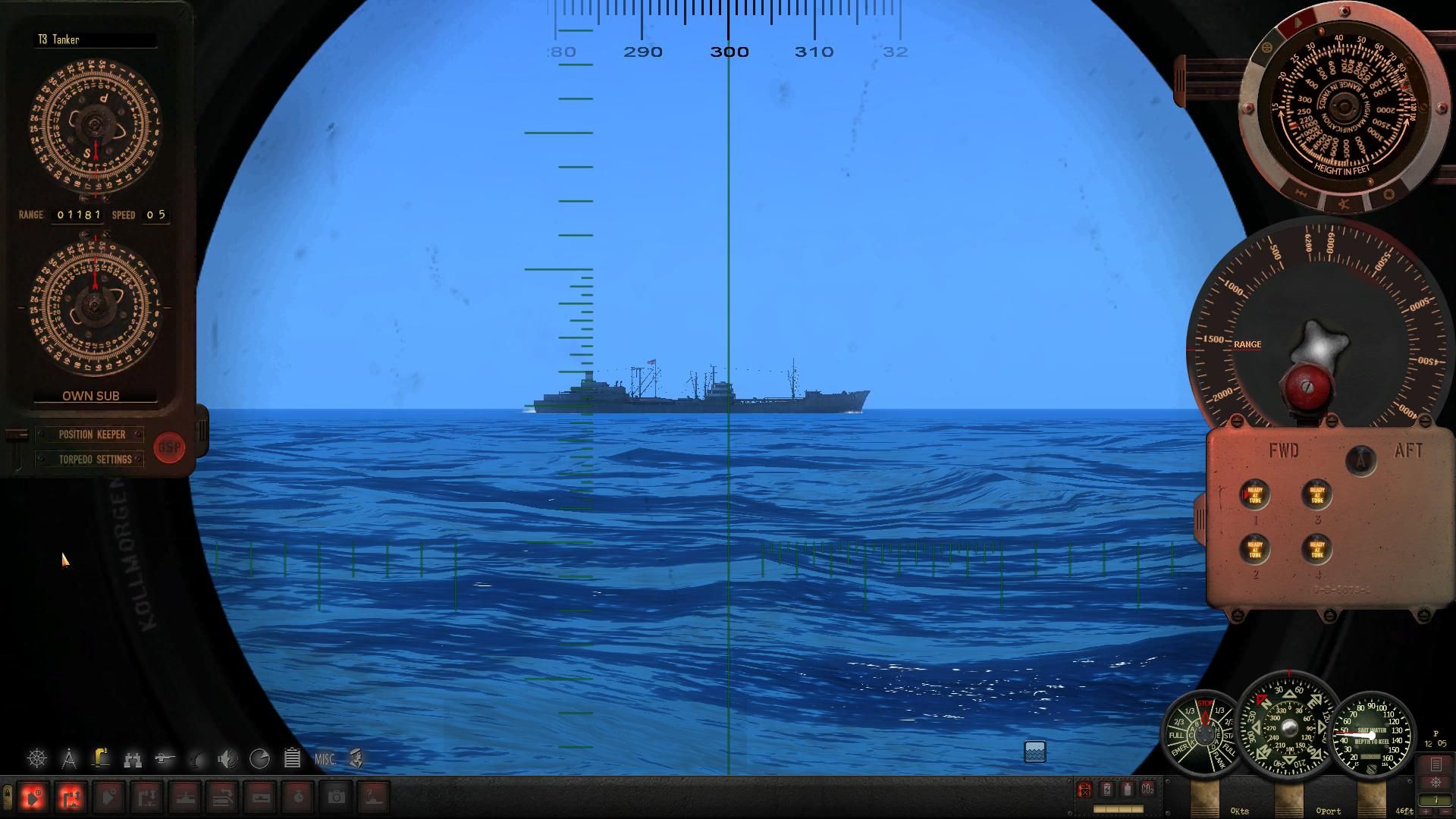 the midpoint of the hypotenuse is bearing 315 degrees, half way between 270 and 360 degrees, and the range has stopped decreasing at this point, the aob is starboard 90 degrees. 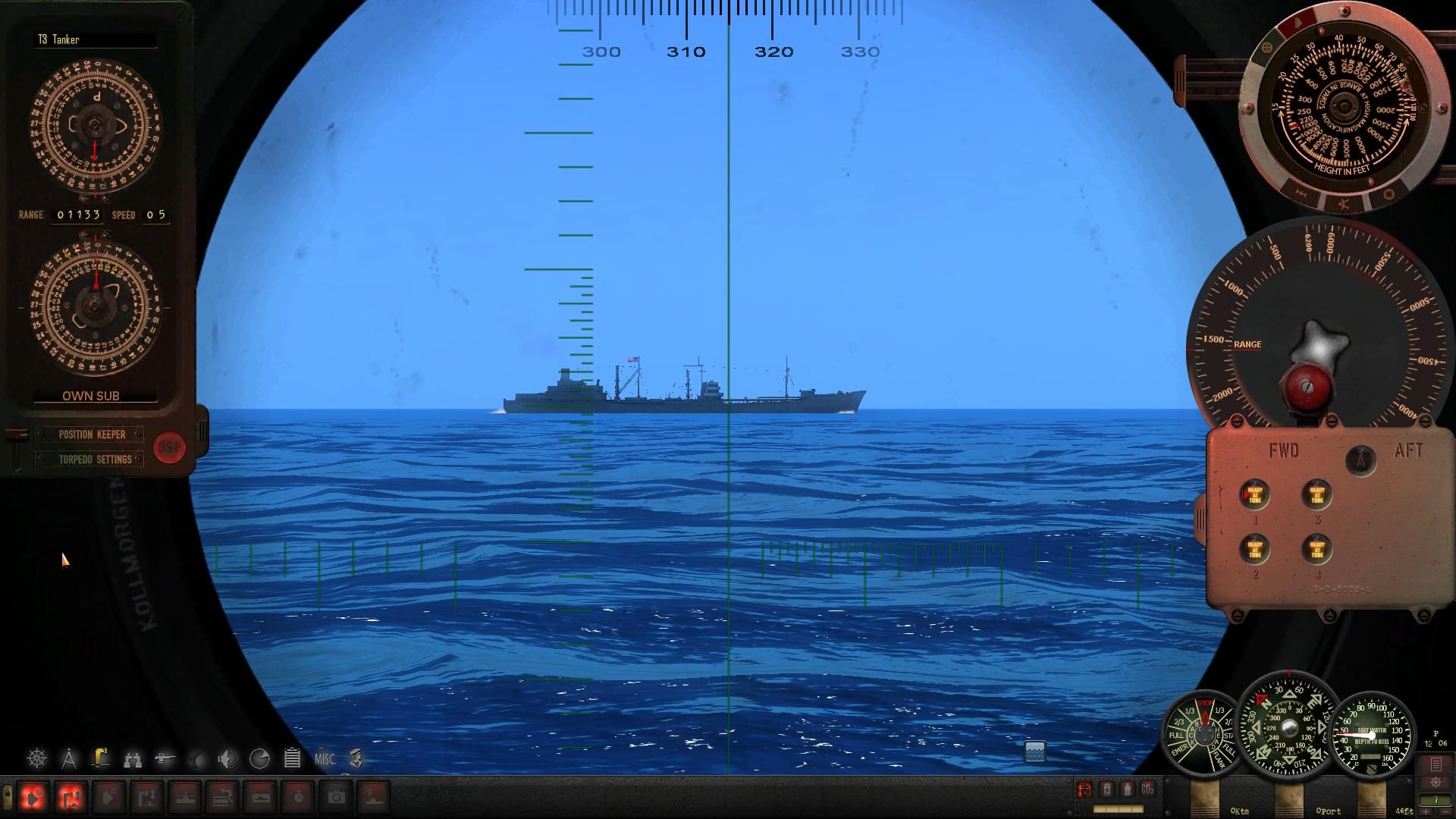 next one shows range increasing as the target moved thru the midpoint. 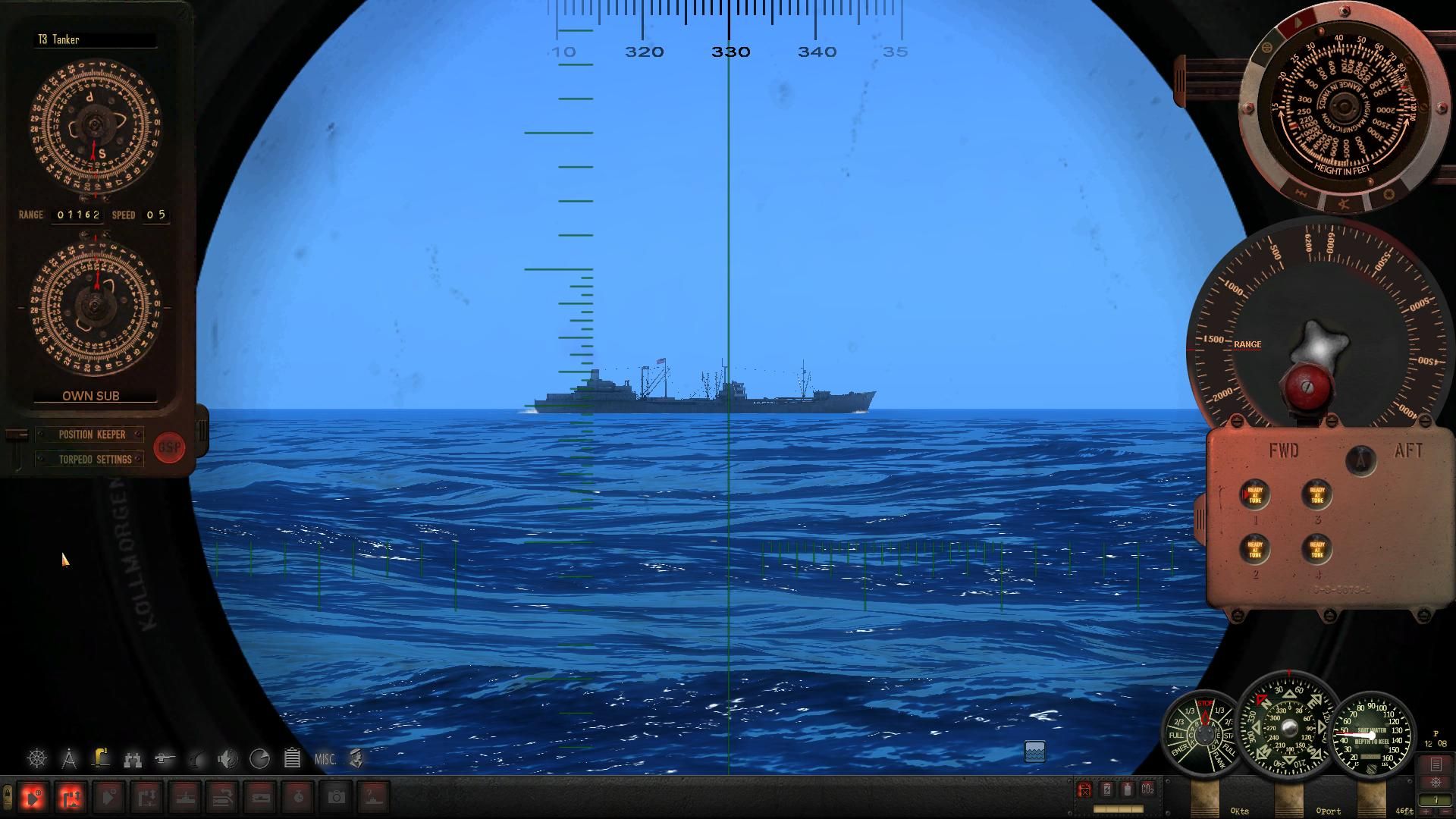 the next picture shows the bearing I could have started firing on, but I waited, from bearing 342, I could have fired on every continuous bearing, at least to zero degrees, and probably more, over 18 firing bearings. 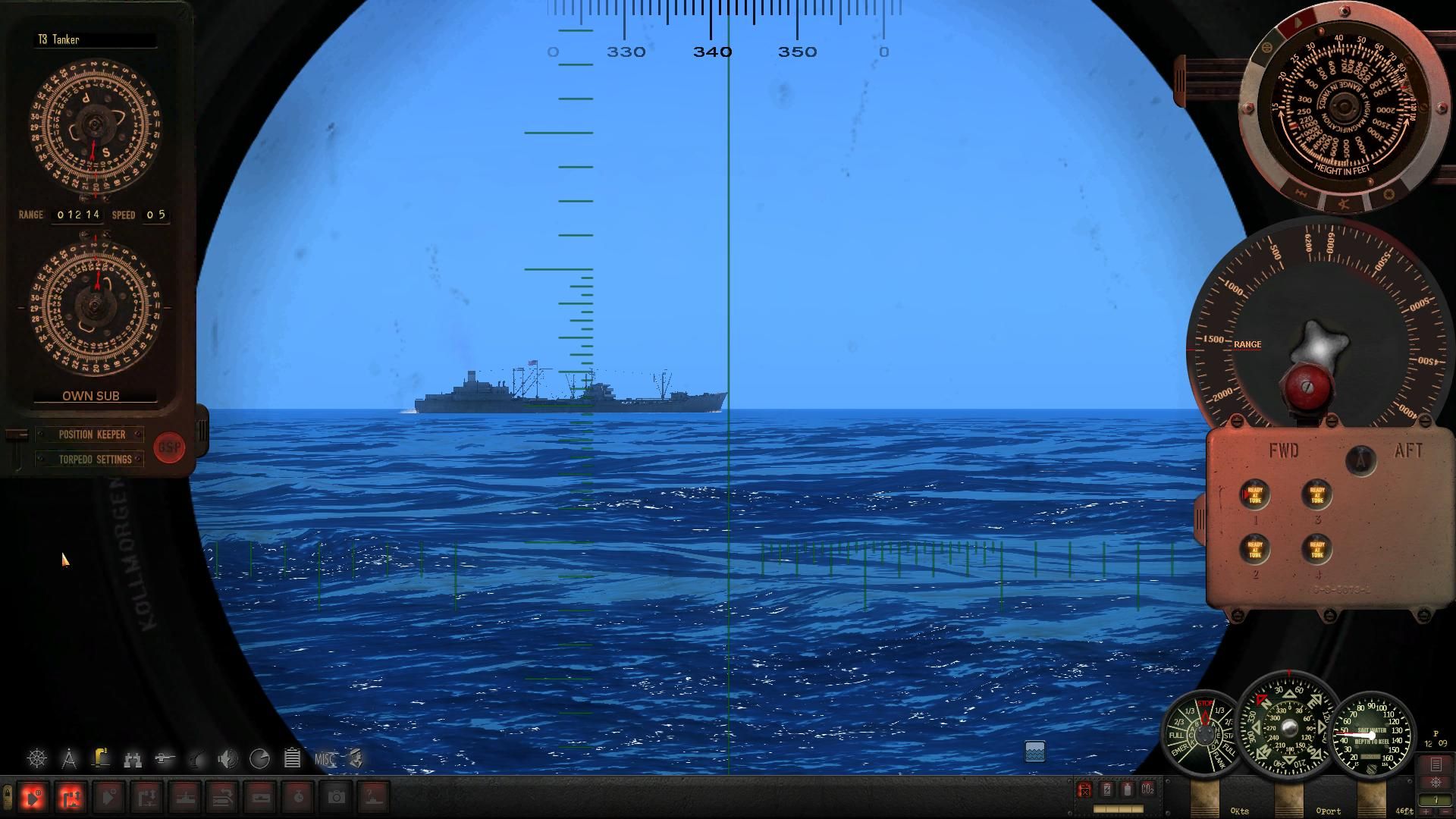 in the next picture, I began firing on bearing 352 degrees, aiming for the stern first, the aob here is starboard 127 degrees.  next pic is aiming at midship. 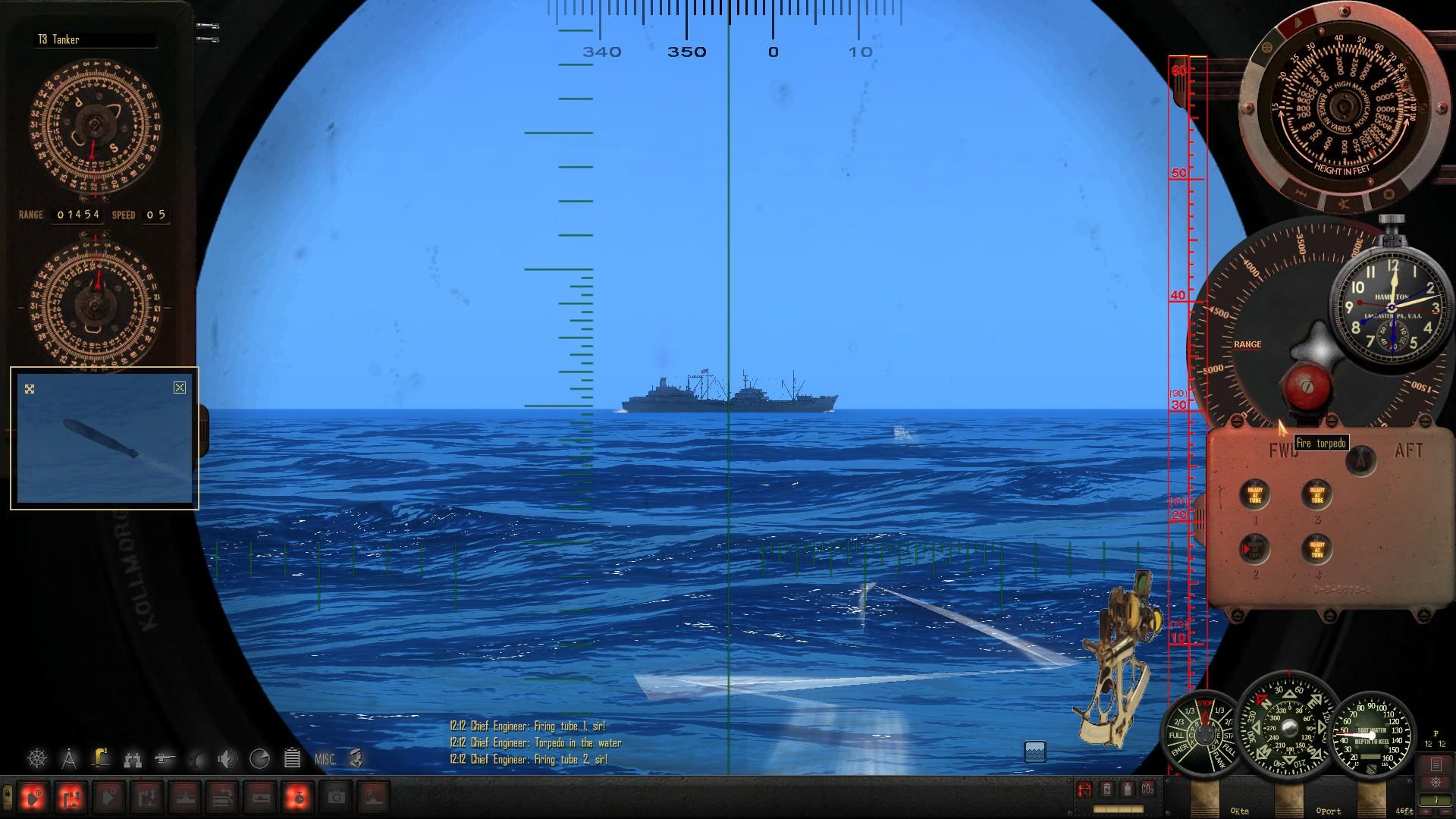 next is last torpedo aimed at the bow.  next is torpedoes on the way, it looks like a divergent spread, and I fired the torpedoes to create a divergent spread, but the torpedoes will all hit in the same area, that is because the target is going away. 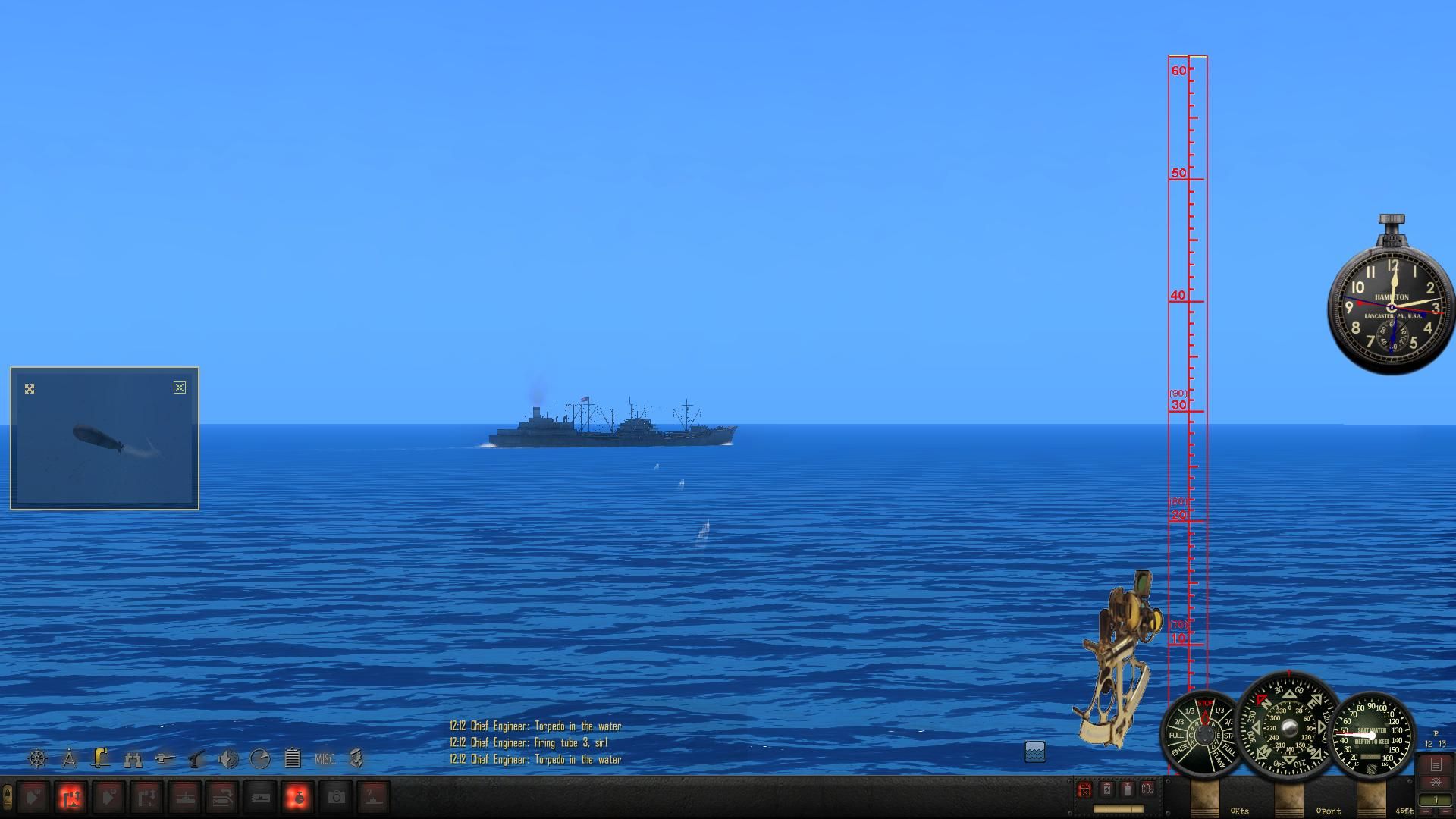 next; first torpedo hitting the stern. 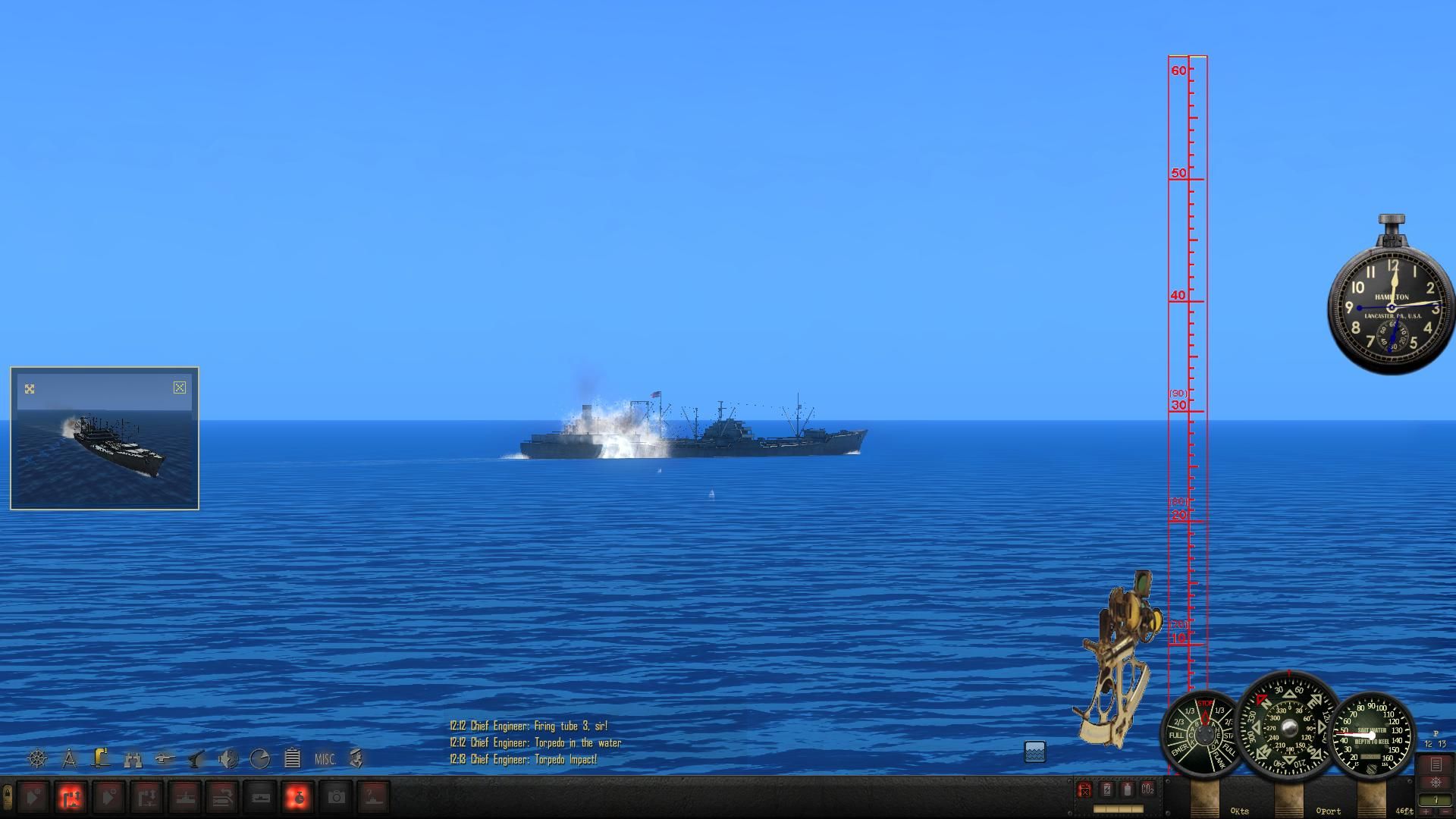 next; 2nd torpedo hitting the stern. 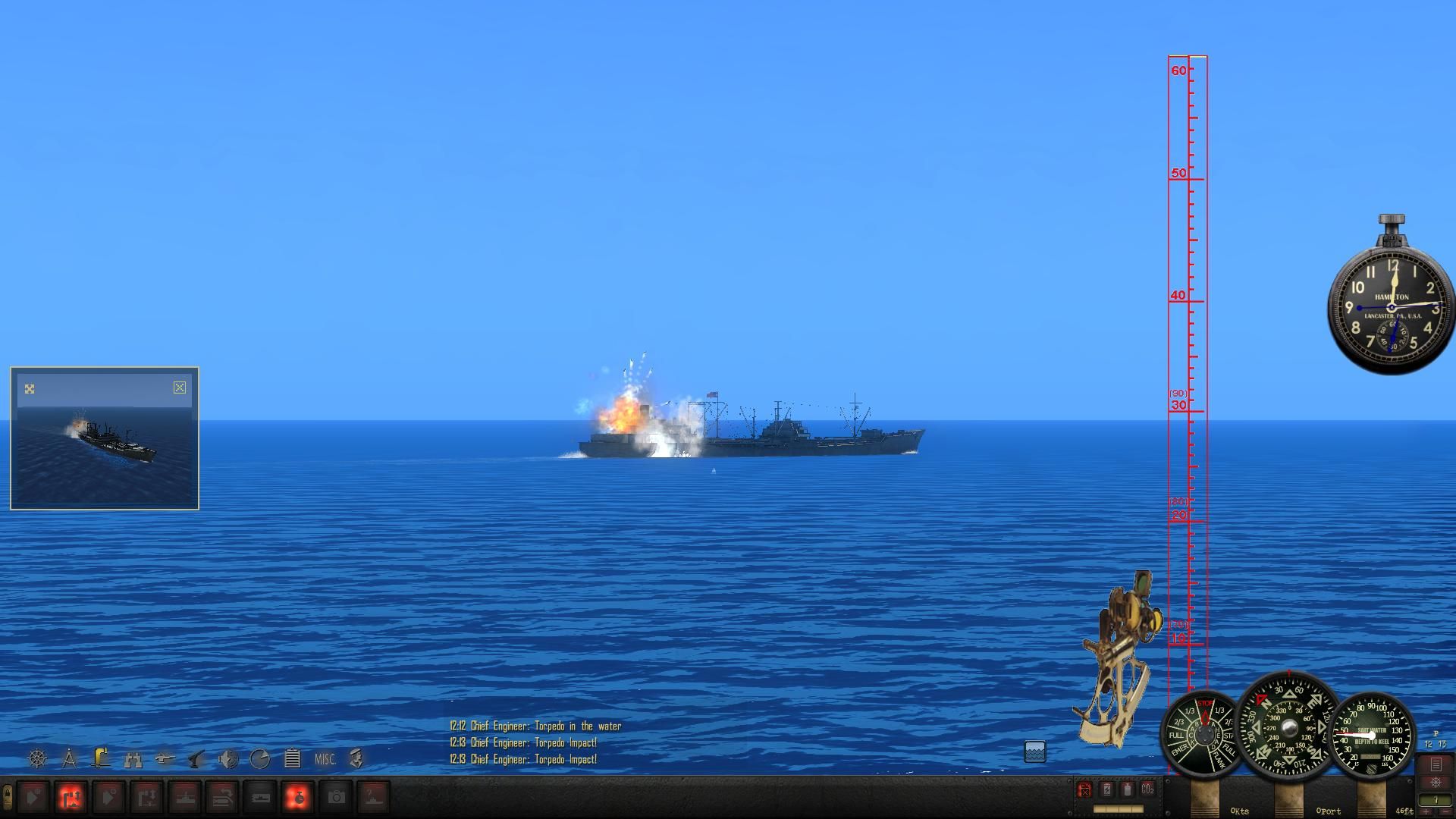 next; 3rd torpedo hitting the stern. 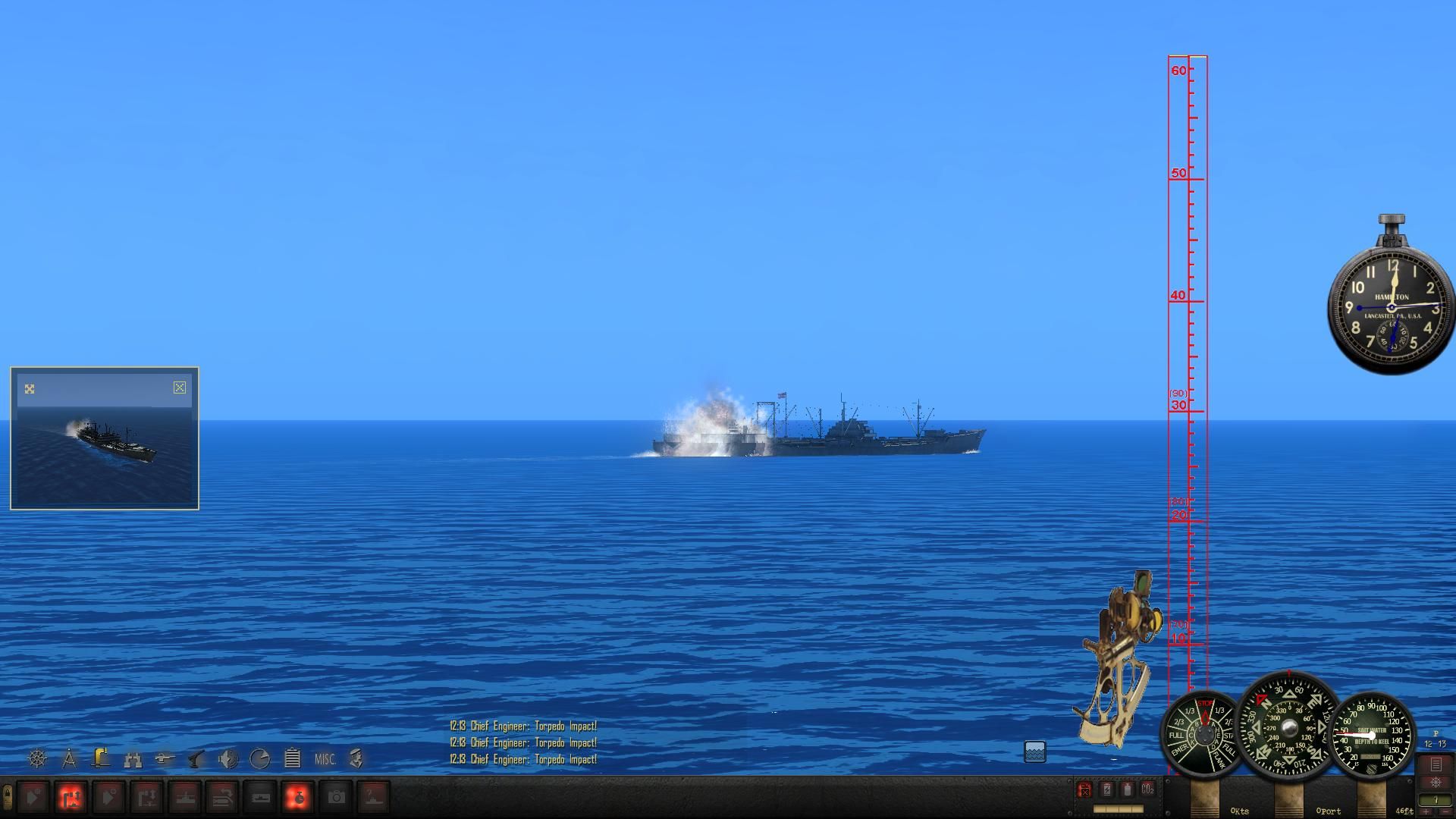 so more work has to be done, for all torpedo speeds and target speeds, maybe in a month, it might be finished, and incorporated into the combat information mod. I think this is a really cool method, and it seems to have more firing bearings than the constant bearing method.
__________________
Her gun crew had guts, however, for from her canting bow came a half dozen well-aimed rounds. How they pointed and trained their gun on that tilting platform will long remain a wonder, and their dedication in keeping up the fire until they went under would be a matter of pride to any nation. O'Kane, Richard. Clear the Bridge!: The War Patrols of the U.S.S. Tang |

|

|
 06-18-18, 07:28 PM
06-18-18, 07:28 PM
|
#4 | |
|
Captain
 Join Date: Aug 2009
Posts: 481
Downloads: 71
Uploads: 3
|
Quote:
You are way off man. Not one of the three methods has anything to do with the track angle. The constant bearing method works on *any* track angle. I don't have time to try and dig through all these walls of text just now, but I will see if I can't figure out where you're going wrong and give a more detailed response a little later when I have more time.
__________________
My SH4 LP |
|

|

|
 06-19-18, 12:14 AM
06-19-18, 12:14 AM
|
#5 |
|
Watch Officer
 Join Date: Apr 2005
Location: massachusetts
Posts: 334
Downloads: 237
Uploads: 0
|
did I say there wasn't a solution for any angle colonel? I don't recall I ever did, the tdc doesn't generate a bunch of bearings to hit, it generates one bearing as a hitting bearing, the other bearings that can hit along with the generated bearing, are applied by the tdc as offsets from the generated bearing, as the target moves, it generates one bearing. look at the tfcm, theres diagrams there that show alot more angles then just the ninety, you won't get a divergent spread in most angles, they would have to be 90 or near ninety degrees, the idea in constant bearing method was to hit aft to forward and cover the whole target, thats a straight line and implies a rt where you can use the whole targets length, how could you do that with a target coming at you in a 20 aob? if you can do the calculations for an angle like that manually and still get your shot off, your the best colonel!
take a look at the pictures, I fired those torpedoes to create a divergent spread, it still ended up as longitudinal, hitting in the same place, but I proved it works, I don't care what it's called, just that it works, and the constant bearing method, the way I learned how to do it, matches what tang did. you can come with any proof, but then , you also have to prove where I said it couldn't be any angle. I know I said the only way you can get a divergent spread was in a ninety, that's different from what you say I said, I was talking about a spread pattern, not an angle. in order to be a method or methodical, it has to be consistent, your logic wouldn't be consistent over every bearing, the 90 would be
__________________
Her gun crew had guts, however, for from her canting bow came a half dozen well-aimed rounds. How they pointed and trained their gun on that tilting platform will long remain a wonder, and their dedication in keeping up the fire until they went under would be a matter of pride to any nation. O'Kane, Richard. Clear the Bridge!: The War Patrols of the U.S.S. Tang Last edited by greyrider; 06-19-18 at 01:15 AM. |

|

|
 06-19-18, 01:39 AM
06-19-18, 01:39 AM
|
#6 | |||||
|
Captain
 Join Date: Aug 2009
Posts: 481
Downloads: 71
Uploads: 3
|
Quote:
Quote:
Quote:
You have explicitly stated, multiple times, that the Constant Bearing Method is intended for a 90 degree track. This is incorrect. The track angle is irrelevant to the firing method used. Quote:
Quote:
Easy peasy. No calculation required. There is a device at the bottom of your periscope that is designed to measure ship length in degrees. In low power mode, each hash mark is 1 degree. Well, depending on mods and screen res. It's correct if you're using something like OTC anyways. As for the rest, I'm working on it, but give me some time. I've got multiple walls of text to sift through and I want to be both thorough and accurate. That being said, I gather from your response that you're going all, "who is this arrogant SOB and why should I listen to him?". Fair enough. I guess that for now, all I can do is assure you that I know the material.  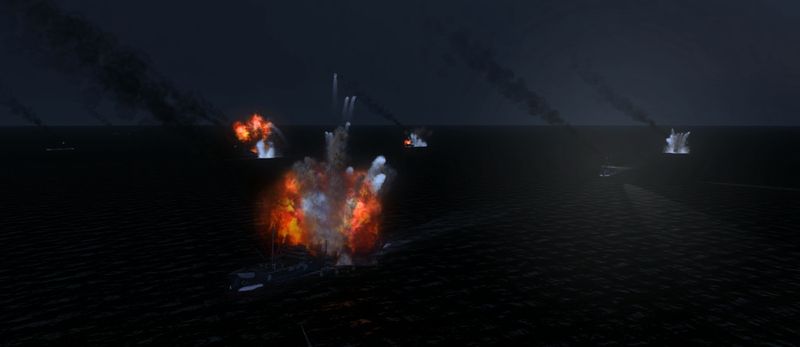 Thoroughly.
__________________
My SH4 LP |
|||||

|

|
 06-19-18, 07:38 AM
06-19-18, 07:38 AM
|
#7 |
|
Watch Officer
 Join Date: Apr 2005
Location: massachusetts
Posts: 334
Downloads: 237
Uploads: 0
|
I don't think your arrogant colonel, your just trying to prove a point, so post away and take your time, I'm not going anywhere.
I know about the telemeter, in the cic mod, I have telemeter ranges for warships and merchants, and I modified hitmans mod to put a sheet of formulas from the tfcm that measure target length and target range? do I use them, not very much. I looked at one of your videos, you looked kind of rushed when you made it, you basically showed me some confusion, I don't want that for me, so from any angle, I can get into a ninety, that makes things easy, I'm not rushed, it eliminates alot of the map plotting your doing, becus the course and aob are known. so take your time, I don't care about any angle you make for the post, I want to see you hit where you aim at in a divergent spread, aft to forward. regards
__________________
Her gun crew had guts, however, for from her canting bow came a half dozen well-aimed rounds. How they pointed and trained their gun on that tilting platform will long remain a wonder, and their dedication in keeping up the fire until they went under would be a matter of pride to any nation. O'Kane, Richard. Clear the Bridge!: The War Patrols of the U.S.S. Tang |

|

|
 06-19-18, 08:52 AM
06-19-18, 08:52 AM
|
#8 | |
|
Captain
 Join Date: Aug 2009
Posts: 481
Downloads: 71
Uploads: 3
|
Quote:
I'm not talking about range. You asked about spread. Consider:  The periscope is in low power mode. Two questions. 1: In a divergent spread, what spread angle yields 100% coverage? 2: If a single torpedo is desired, and the TDC is set to track the center of the ship, what spread must be entered to hit just under the stack? All you must do to get the answers to these questions is read the telemeter. Answers: This works for any range, AOB, and ship length combination. No calculation required. I would be curious to know which video? If it's one of my old S-Boat videos, you really should note the deliberately unfavorable circumstances of those attacks. Being rushed at the end is due to not having radar, map contacts enabled, or even OTC, combined with a strong desire to forgo using the TDC to solve the angles for me due to historical accuracy reasons.
__________________
My SH4 LP |
|

|

|
 06-20-18, 12:14 AM
06-20-18, 12:14 AM
|
#10 |
|
Watch Officer
 Join Date: Apr 2005
Location: massachusetts
Posts: 334
Downloads: 237
Uploads: 0
|
definition:
Method: a particular form of procedure for accomplishing or approaching something, especially a systematic or established one. there are 360 angles of targets closing on a submarine, then there's 360 angles of going away targets, that's 720 bearings that need to be consistent, but there's also combinations of those angles, so it's more like 360 to the 4th power, or 16,796,160,000 different ways targets can be either closing or going away from the submarine. in a divergent spread, the idea is to have at least 100 percent coverage over the targets length. from tfcm: (d) The total amount of spread used in a salvo may be spoken of in terms of total percentage of target length covered. total length it said, you will only get that with something that's straight, that implies a ninety degree angle, you say you would use a percent of a 20 degree target, well that's fine, but would you be able to see and aim at the stern, would you be able to aim at it and fire if you can't see it? would you see the midship good enough to aim and fire at that point, aft to forward, or the bow in that almost 17 billion ways a target will present itself? even by apprearence, your not going to see the whole target in some, and in many, of the angles that they will close or go away, so if you have no point to shoot at, then its not a method, becus methods are consistent. the ninety degree angle is consistent tho, it never changes, so therefore it could be considered a method. it's pretty late to read and think about your post right now colonel, ill look at it tomorrow, and let you know. I did write this earlier after thinking this morning of what you posted last night.
__________________
Her gun crew had guts, however, for from her canting bow came a half dozen well-aimed rounds. How they pointed and trained their gun on that tilting platform will long remain a wonder, and their dedication in keeping up the fire until they went under would be a matter of pride to any nation. O'Kane, Richard. Clear the Bridge!: The War Patrols of the U.S.S. Tang |

|

|
 06-20-18, 07:53 AM
06-20-18, 07:53 AM
|
#11 | |||
|
Captain
 Join Date: Aug 2009
Posts: 481
Downloads: 71
Uploads: 3
|
Quote:
You might be surprised at how much of the stern you can see at 20 degrees AOB. 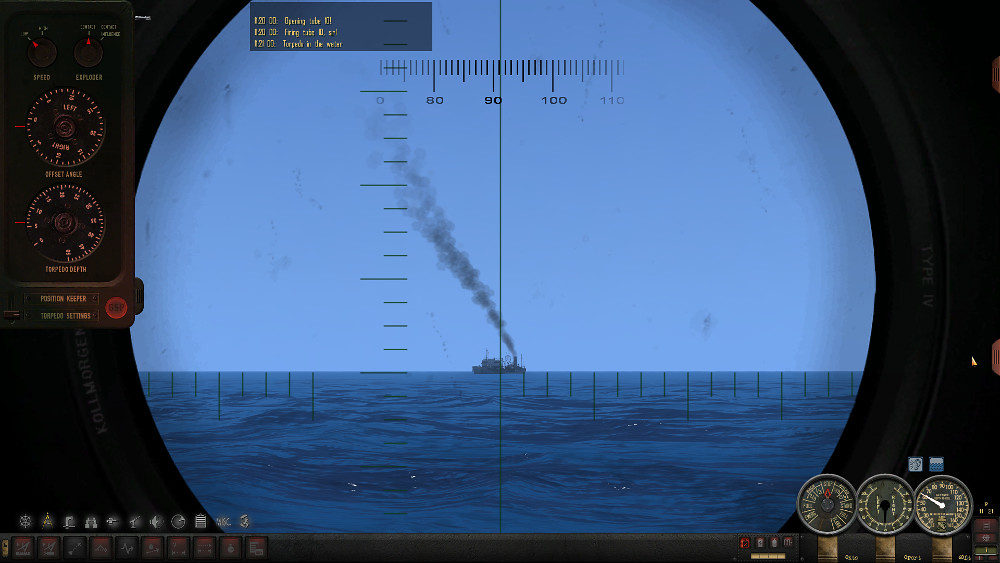 And if you can see it...  You can hit it! The real problem with shooting at 20 degrees AOB isn't what parts of the ship you can and can't hit. It's the torpedoes bouncing off the hull combined with the fact that a small shift in target course corresponds to a large gyro angle difference. Quote:
Woah there. No. Not at all. Not only does that manual not say that, it says the opposite. Quote:
The *maximum* recommended spread is a 100% spread. Also note that it uses the words "effective target length". Not the absolute target length. Further, that manual recommends that you consider using less spread when accurate target data is available. See - 600 (A) and 606. DETERMINATION OF COVERAGE for a couple of instance of this recommendation. I wonder if you're laboring under the impression that the primary purpose of spread is to hit different parts of the ship. It's not. The purpose is to increase the probability of at least some torpedoes hitting in the event of errors and/or evasive action. Incidentally, it also increases the probability of at least one torpedo missing as well. If we fire three torpedoes in a 100% spread, we are accepting that one of those torpedoes will almost certainly miss, in order to substantially increase the odds that the other two will hit. If your tactical situation is good enough that you don't need to just accept that some of your torpedoes will likely miss, then you should not use a 100% spread.
__________________
My SH4 LP |
|||

|

|
 06-21-18, 12:13 AM
06-21-18, 12:13 AM
|
#12 |
|
Watch Officer
 Join Date: Apr 2005
Location: massachusetts
Posts: 334
Downloads: 237
Uploads: 0
|
yup! your right colonel, good shot to, I agree with you , no, I know that 100 percent is all that's needed, and it really is about getting at least one or some of the torpedoes to hit, I agree with everything you just said.
but I would just like to add something you said in last post, when you showed the pic of the nac, and oac, you said that the 90 angle was just a coincidence, im going to have to disagree with you on that, and i wrote the rest of this earlier today as well, so I might not be up to date with the post as far as replies, so bear with me, anyway, what I have to say is below. i think its from being a coincidence colonel, it's a 45-45 right triangle, with one look at the range to target, legs lengths of the triangle are known, and then one simple multiplication problem and the length of the hypotenuse in known, so what do you have, you have a triangle with all three side lengths known, your dealing with an isosceles triangle, both base angles are congruent, the sides opposite those angles are congruent, the interior angles, 45, 45, 90, add to 180. this is only reinforcing my belief that these firing methods are based on geometric principles of the rt, so maybe the check bearing method could be a 30-60 right triangle, another well known and established geometric shape with known characteristics, i don't think there is any coincidence colonel. there are three methods to fire, and there just happens to be three special cases of the right triangle, the regular right triangle, the 45-45 rt, and the 30-60 rt, this is way more than a coincidence colonel. you said that the constant bearing method encompasses all bearings, so if that's the case, then only one method would be needed right? then what are the other two methods for, the same thing? of course not , they are similar but different methods, it has to be angles that make the method, what else could it be? as far as your picture to find the coverage, the length would subtend a certain amount of degrees, you would divide that by the number of torpedoes fired, to determine the coverage, so if a target subtends 5 degrees and you want to fire 4 torpedoes at it, the coverage would be one hundred and twenty-five percent.
__________________
Her gun crew had guts, however, for from her canting bow came a half dozen well-aimed rounds. How they pointed and trained their gun on that tilting platform will long remain a wonder, and their dedication in keeping up the fire until they went under would be a matter of pride to any nation. O'Kane, Richard. Clear the Bridge!: The War Patrols of the U.S.S. Tang |

|

|
 08-14-18, 04:50 PM
08-14-18, 04:50 PM
|
#13 |
|
Electrician's Mate
 Join Date: Jun 2013
Posts: 139
Downloads: 184
Uploads: 0
|
Ahoy ColonelSandersLite I would definitely be interested in seeing any videos you have made whether rushed or not. RR posted a great one on the Dick O"Kane manual targeting method. Wernersobe's videos are great also. If you don't mind could you post a link to yours? It would be appreciated. To me AOB and target speed is critical. I get the angle on the bow plugging in the target's course into the PK . Range with the stadimeter. I always seem to have plenty of time but sometimes (more often than not) the target will veer off then it's chaotic! Shooting John Wayne style.

|

|

|
 08-21-18, 04:55 PM
08-21-18, 04:55 PM
|
#14 | |
|
Silent Hunter
 Join Date: Dec 2004
Location: AN9771
Posts: 4,892
Downloads: 300
Uploads: 0
|
Quote:
The firing point procedure basically deals with how long or where the Approach Officer (You, the guy looking through the scope calling the shots) keeps the periscope vertical line pointed to measuring range and bearing and aim at the thing to be hit. The TDC operator then adjusting the generated bearing and range (from position keeper I guess) to the actually observed bearing and range whenever the Approach officer calls it valid. The following is a simplified reduction of the fully explained firing procedures. Go read them yourself for the details. "Check Bearing" uses an single instant observation of bearing and range to correct the solution for a single torpedo. The torpedo is fired after the TDC dials show a valid solution and spread and the gyro angle in the tube matches to what is commanded by the TDC. The single instant observation is repeated if tracking of the torpedoes to the target is deemed insufficient after launch. Multiple torpedoes are fired after the TDC operator has made his corrections and the torpedo tracking seems good. "Continuous Bearing" is a prolonged version of "Check Bearing". The Approach Officer keeps the vertical line on the desired spot for a longer period while the TDC operator twists the magic knobs to correct the solution. If the approach officer cannot keep the scope pointed he calls out that his measurements are invalid. Again firing is done under the same conditions as above. "Constant Bearing" is basically a delayed pre-set version of the Check bearing method. The Approach officer sets the periscope angle ahead of the target bow. The TDC operator does his magic knobs thing again. Assistant TDC operator checks the validity of the solution, spread and gyro matching. The Approach officer then calls "Fire" when the intended impact point passes through the vertical periscope line. For subsequent torpedoes the same procedure is repeated for different target locations. Or with longitudinal spreads (firing of other tubes are delayed as aft-target-hull parts pass the periscope line later) the same relative bearing is used to drive the TDC. Which one you choose depends on how you can replicate them in the game. Constant bearing is basically the Okane method. No need for explanation there. Check bearing is basically using the position keeper running, and point the periscope once (no locking). Then send measured bearing and range by feeding data to the TDC. AOB and speed won't be corrected so as time passes the solution might still diverge from the real target track. But I think this applies to all three procedures. Continuous bearing procedure in game can be simulated as Check bearing with locked scope on target. It won't update the bearing and range to the TDC until you send it though. It's not really a continuous update of the TDC. Just looks like it. Maybe fits best with the automatic TDC realism option turned on. Last edited by Pisces; 08-21-18 at 05:13 PM. |
|

|

|
 12-04-18, 10:21 PM
12-04-18, 10:21 PM
|
#15 |
|
Sonar Guy
 Join Date: Mar 2007
Location: The FREE State of FLORIDA
Posts: 399
Downloads: 215
Uploads: 0
|
Really, I'm enjoying these discussions. Quietly learning a lot!
Thanks!
__________________
"It is well war is so terrible, lest we should grow too fond of it" - C.S.A. General Robert E. Lee "Only the dead have seen the end of war" - Plato  Gone but not forgotten, RIP Dave "LeoVampire". |

|

|
 |
| Thread Tools | |
| Display Modes | |
|
|
